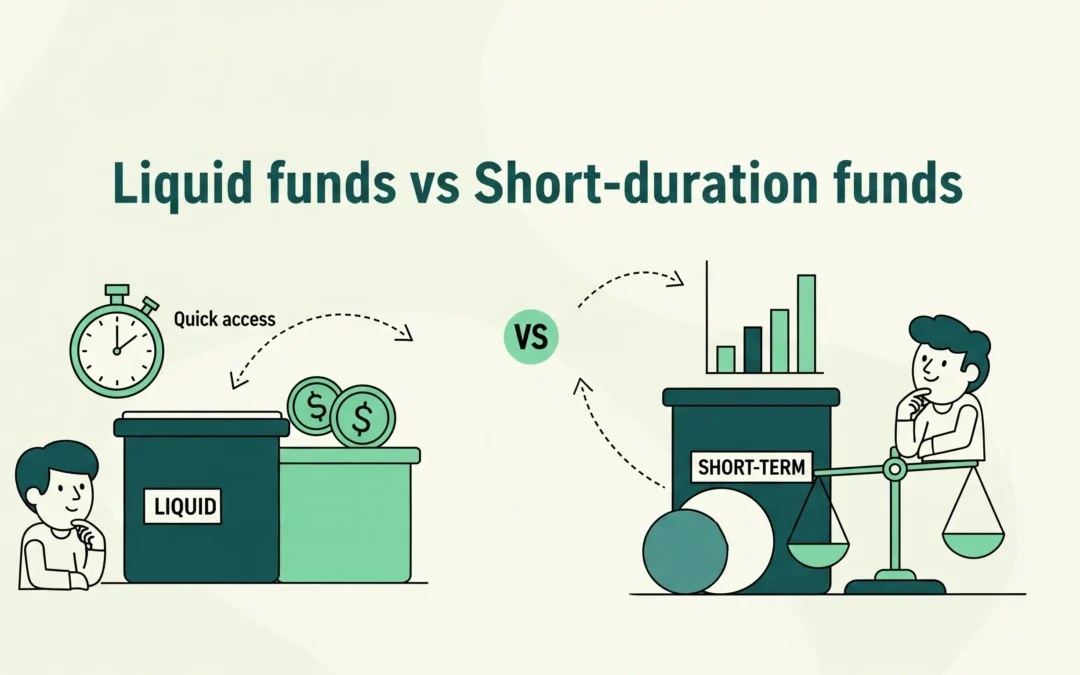There are various investment options available for investors. The suitability differs based on various factors. Liquid funds and short-duration funds are two such options that are considered safe and stable. These funds offer moderate to high liquidity, but differ in maturity periods from a few days to 1–3 years.
However, both terms may seem confusing, and investors may perceive them as the same thing. This article will help you understand the meaning and difference between them.
What is a liquid fund?
A liquid fund is a kind of debt mutual fund that focuses on investing in money market securities with maturities as short as ninety-one days, such as Treasury Bills (T-Bills), Commercial Papers (CPs), and Certificates of Deposit (CDs). These funds, which are known for their high liquidity, low risk, and steady returns, are made for the short-term parking of excess funds.
Liquid funds, which are less susceptible to interest rate swings than long-duration debt funds, typically offer slightly higher returns than savings accounts, although returns are not guaranteed.
Key Features:
- Investing in securities with a maturity of 91 days
- Minimal credit risk and low-interest rate risk in well-managed funds
- T+1 liquidity can be redeemed in a single working day.
- Ideal for short-term objectives, like emergency funds
What is a Short-duration fund?
Another type of debt mutual fund is a short-duration fund, which makes investments in fixed-income securities with an average portfolio maturity of one to three years. By assuming a little bit more risk through exposure to longer-duration and occasionally lower-rated securities, these funds seek to outperform liquid funds in terms of returns.
They work best for investors who have a moderate appetite for risk and a medium investment horizon.
Key Features:
- Average maturity duration is 1-3 years.
- Higher than liquid funds, moderate interest rate risk
- Potentially greater returns with some variations in NAV
- Fits well with one to three-year financial objectives (e.g., tuition fees, down payment)
- Should the fund contain lower-rated bonds, there may be some credit risk.
Liquid Funds vs Short-Duration Funds: Key Difference
- Potential vs. Return Consistency: Although liquid funds provide more consistent returns, they are comparatively lower. When capital preservation is your main concern, they are perfect. Depending on market conditions and interest rate cycles, short-duration funds may yield higher returns.
- Market Sensitivity: Because of the extremely short maturity of their holdings, liquid funds are hardly affected by changes in interest rates. Although not as much as long-term debt funds, short-duration funds may see changes in NAV in response to changes in interest rates.
- Exit Load and Lock-in: The majority of liquid funds are flexible because they don’t have an exit load after seven days. Some short-duration funds are less appropriate for very short-term needs because they have an exit load for early withdrawals (usually before six months).
- Risk Profile: Short-duration funds may be subject to credit risk if the fund manager incorporates lower-rated instruments to boost returns, even though both are thought to be safer than equity or long-term debt funds. Conversely, liquid funds minimise this risk by primarily sticking to short-term, high-quality instruments.
- Ideal Use Cases: Liquid funds are useful when saving for impending expenses such as an insurance premium, a trip, or holiday shopping. Short-duration funds are better suited for planned expenses that will occur within the next year or two, like a down payment for a car or school expenses.
Let’s look at the difference table:
| Feature | Liquid Funds | Short-Duration Funds |
| Investment Horizon | Ultra short-term (days to 3 months) | Short to medium-term (1 to 3 years) |
| Underlying Securities | T-Bills, CDs, CPs (maturity ≤ 91 days) | Corporate Bonds, G-Secs, NCDs |
| Risk Level | Very Low | Moderate |
| NAV Fluctuation | Minimal | Mild to moderate |
| Liquidity | High for liquid funds (T+1), moderate for short-duration funds (typically T+2, though it may vary slightly based on the fund and time of redemption) | Moderate, as T+2 redemption is available |
| Return Expectation | 3.5% – 6% (approx.) | 5% – 7.5% (approx.) |
| Best Suited For | Emergency fund, idle cash | Goals within 1–3 years |
Bottomline
The conclusion can be drawn that liquid and short-duration funds vary on various grounds. The Net Asset Value fluctuates comparatively more in short-duration funds. The maturity period is so small in liquid funds that enough fluctuation does not happen. People who are willing to invest but also maintain funds for emergencies may opt for liquid funds.
While individuals who have extra cash that they will not need for a year or 3 may choose short-duration funds. These are safe options for investments when compared to equity.


